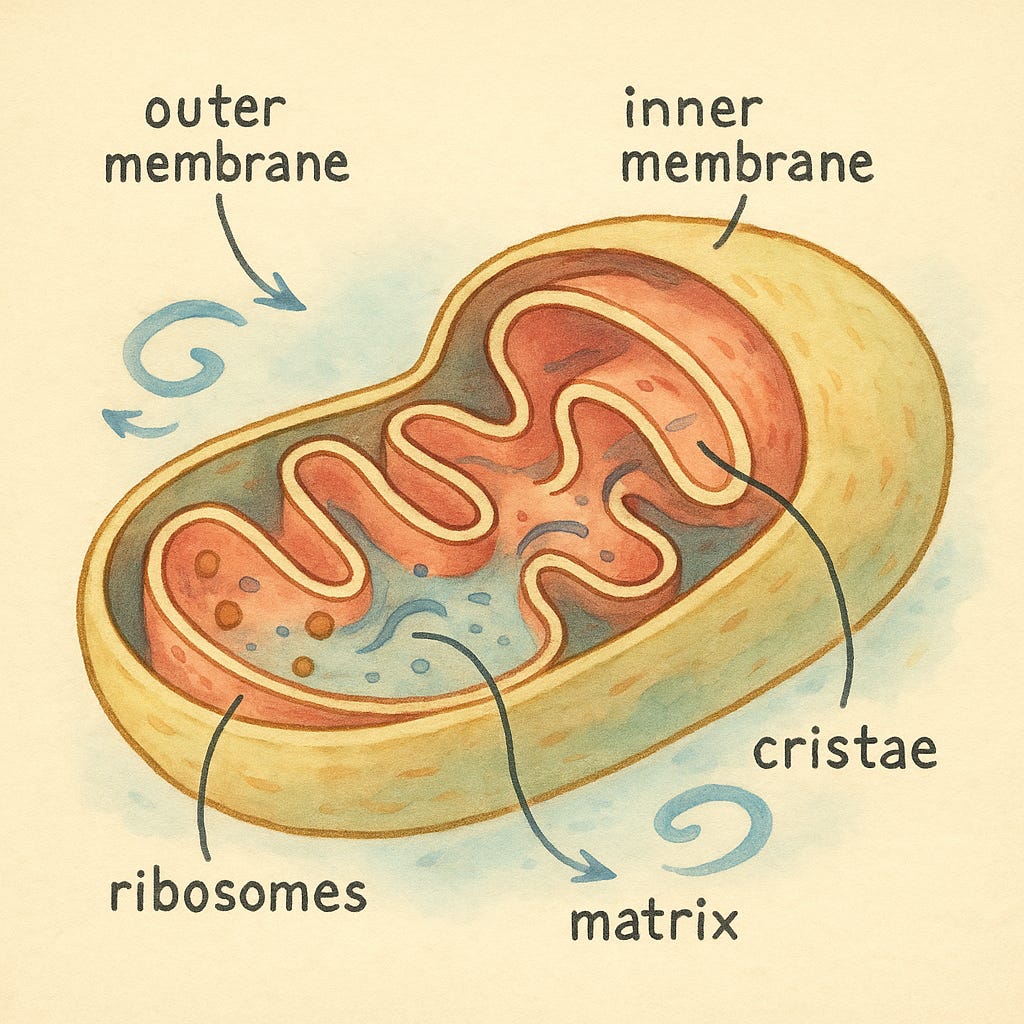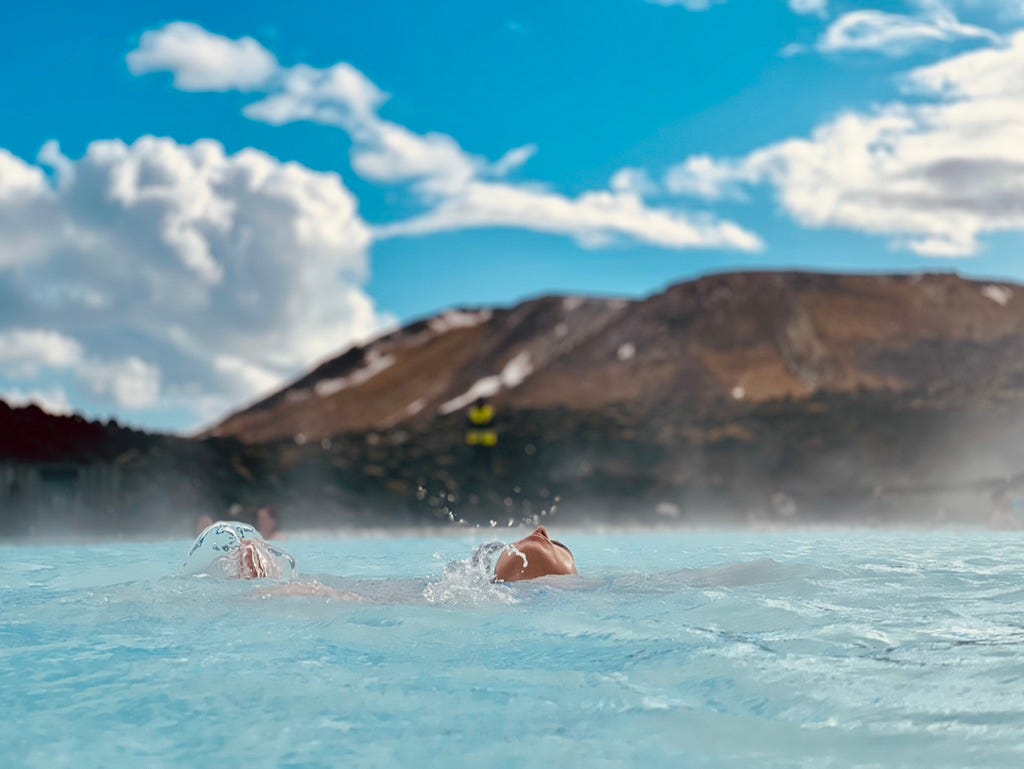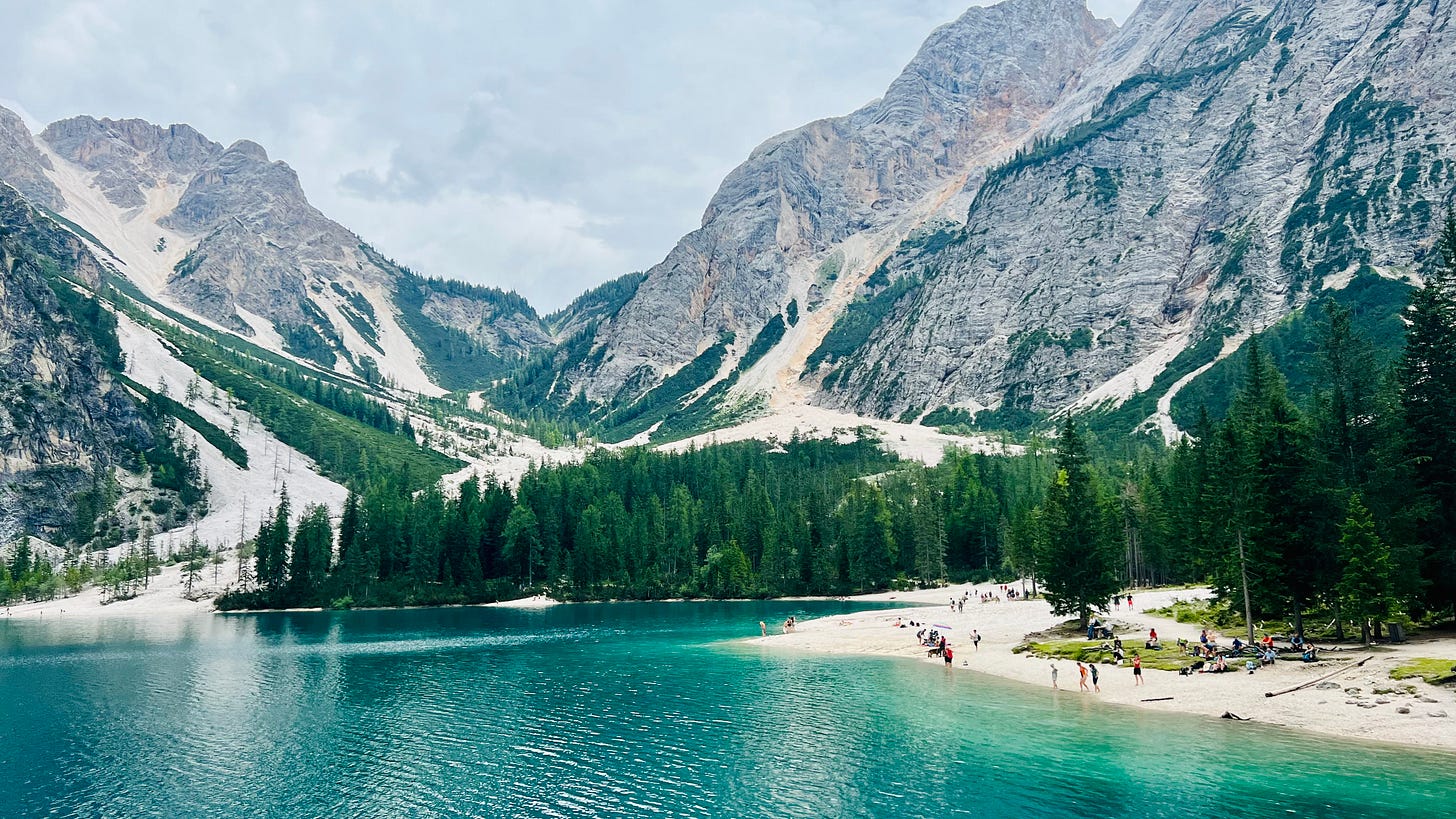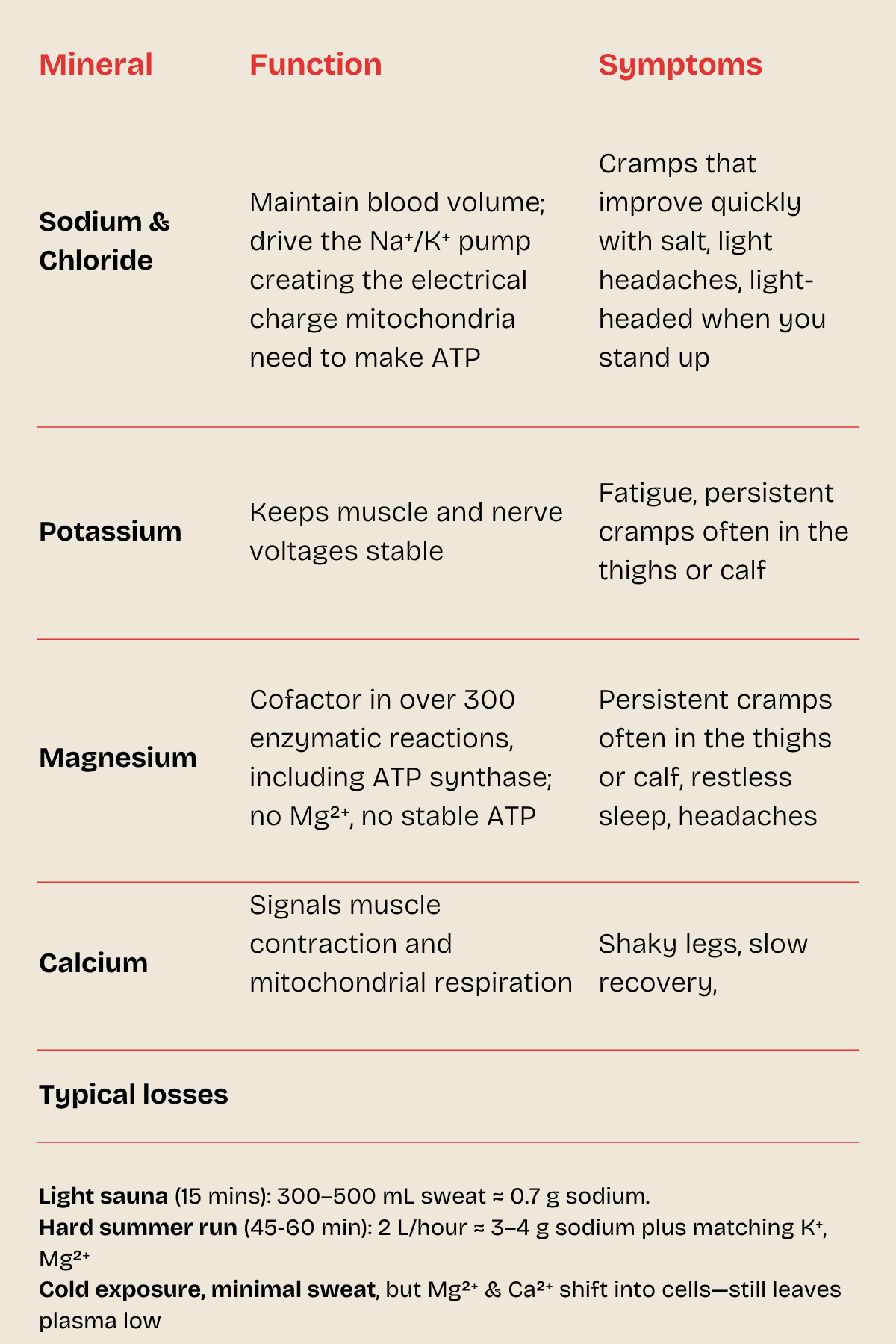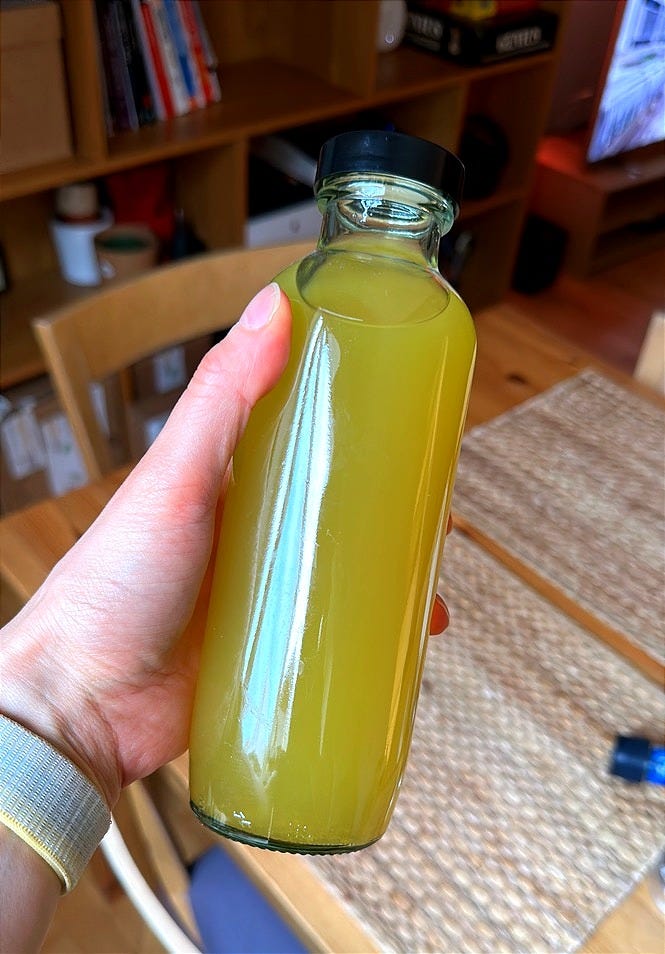Heat, Cold & Mineral Salt: How temperature swings tune mitochondria and sharpen metabolism
Plus, a homemade drink to replenish those lost electrolytes
Goodbye June, Hello July: When the heat takes over.
With London turning furnace-hot, I’m longing for the crisp, cold air of the Dolomites on my cheeks. Although I love the water, I’ve always been a mountain lover and preferred the pine-lined lake shores and cold swimming to the crowded seaside in summer. I believe this explains a lot about me and my devotion to sauna practice.
Which brings me back to 2014 and my very first ski lessons.
Those who know me well—looking at you, R—know two things: (1) I used to chase the last chairlift like a golden snitch, and (2) I like to vanish into a 90°C sauna, twice a week, non-negotiable.
This habit started when a stoic Scandinavian instructor, whose English vocabulary consisted of “bend your knees,” “no parallel,” and “muscle recovery tonight,” first taught me how to ski. He couldn’t explain to me the biochemistry or why alternating heat and cold exposure mattered, so in my quest to figure it out, I’ve been sweating, chilling, and channelling my Mike Ross-like energy, consuming information like no one you’ve ever seen.
Throughout my research, I came across a few key studies, including Dr. Susanna Soeberg's work on how cold exposure induces mitochondrial remodelling and increases insulin sensitivity in humans.
Headline discovery from all the research across the board?
Alternating heat and cold is hormesis—tiny, calculated stress that sculpts the power plants inside our cells called mitochondria, forcing the body to adapt and upgrade.
Today I’ll unpack how that works, why women and men adapt a tad differently, where electrolytes sneak into the plot, and—because a story without a recipe is just homework—a pineapple-ginger drink that puts those minerals right back where they belong.
Stick with me: the science is spicy, the recipe is easy, and the pay-off is metabolic rocket fuel.
Mitochondria 101: Meet the power plants of our cells
Think of mitochondria as the batteries of the cells in our body. Their primary function is to turn food and oxygen into ATP (adenosine triphosphate), the energy powering your quads to hold a squat or your brain to fire off a sentence.
Throughout history, humans have been exposed to extreme temperature fluctuations, and mitochondria are the key element that have helped their bodies adapt. Think of the people who were living in the Sahara desert, where the temperature varied dramatically across a single day, or the ones living in icy climates like Siberia.
Besides energy conversion, these powerhouses play a key role in other metabolic processes:
juggle calcium
cell growth, redox balance, and signalling
decide when a cell should self-destruct (apoptosis).
Most importantly, they’re shape-shifters: they fuse, divide, and self-recycle (through mitophagy) in response to stress. Two of the most potent, drug-free stressors with a visible effect on mitochondria are heat and cold.
Heat protocol effects on mitochondria (sauna, geothermal water, a July hike)
When the body is exposed to high temperatures, direct sun or sauna — 80°C - 90°C(176 °F) for 10-15 minutes, a few things happen:
Core temperature rises 1-2 °C→ Heat-shock proteins (HSP70/72) refold damaged proteins and tag dying mitochondria for recycling.
PGC-1α surges post-sauna, prompting your cells to build new, more efficient mitochondria.
Blood flow increases by up to 70% in muscles and by 200% in the skin, accelerating the delivery of nutrients and the removal of waste.
Starter dose: Go for two or three 10-15 minute sauna rounds up to two times a week, cooling to normal body temp in between rounds (I usually go for two sessions per week for best results).
Women in the late-luteal phase may feel hotter sooner—trim a minute or two if dizzy.
Cold protocol effects on mitochondria (cold showers, ice baths, plunging into alpine lakes)
Dropping your skin temp below 15 °C (59 °F) spikes norepinephrine (NE) to 300 %; in fat cells that unlocks UCP-1 (Uncoupling Protein 1), turning mitochondria into space heaters (non-shivering thermogenesis). Two things then happen:
COLD + NE flips mTOR ( a protein kinase with a key role in regulating cell growth, metabolism, and autophagy) down, and AMPK up → boost for mitophagy and mitochondrial renewal.
Brown adipose tissue (BAT) becomes active. Because women have more recruitable BAT around their organs, cold exposure is an especially potent metabolic tool for them, and they often experience a larger calorie-burning and insulin-sensitivity boost (Soeberg et al., Cell Metabolism, 2021).
Starter dose: 11 minutes total per week at 10 - 15°C (per Soeberg protocol), split however as needed.
Why women and men respond differently to cold and heat exposure
TL;DR: same tools, subtly different operating systems.
Estrogen upregulates mitochondrial antioxidant enzymes (SOD, GPx), which partly explains why women exhibit less oxidative damage after heat bouts and often recover more quickly.
Progesterone slows cooling, and that’s one reason why the late-luteal phase feels like wearing an invisible wool sweater.
Testosterone boosts muscle mass, so men often see larger absolute gains in mitochondrial density in Type II fibres after repeated sauna. Still, women frequently score better in oxidative efficiency (more ATP per O₂ molecule).
Translation: Adjust duration, not the practice.
Let’s see where minerals come into the picture.
Enter the Electrolytes (a.k.a. the mineral muscles)
Heat and cold both drain or shift four key minerals:
Replenishment 101
Replace 100–150 % of the weight you lost within two hours.
Target 500–750 mg sodium per litre, plus supporting minerals.
4–6 % carbs (1/2 -1 tsp of honey per cup) speeds absorption without spiking glucose.
Now—how do we make that delicious?
Pineapple lemonade - a summer electrolyte dream drink
This drink is summer in a glass: sweet pineapple, spicy ginger, earthy turmeric, a whisper of salt. Drink it cold for its electrolyte benefits or hot as a comforting tea. Yes, it simmers for an hour, but it’s oh, so worth it; your patience will be rewarded with three big, mineral-rich servings.
Yield ≈ 1.2 L (3 tall glasses)
Prep time: 10 min | Simmer: 1 h 20 min
Ingredients:
1 very ripe pineapple (large)
½ Tbsp baking soda
1.5–2 L water
2 cardamom pods
dash of cinnamon
1 star anise
½ tsp turmeric
3 – 4 cm ginger, sliced
Dash black pepper (to activate the curcumin in the turmeric powder)
Hefty pinch salt (¼ tsp) (Celtic salt works best for this recipe)
Method:
Soak the pineapple in lukewarm water with baking soda for 30 minutes; then rinse and pat dry.
Cut off the crown & base, peel the skin, and reserve the flesh for snacking.
Add skin, core, and a few loose pineapple pieces to a pot with spices, salt, pepper, and 1.5-2 litres of water.
Bring to a boil (15 minutes), then simmer for 60 minutes, maintaining a volume of at least 1.5 L.
Cool, strain, bottle, refrigerate. Serve cold over ice or hot as tea.
MINERAL SNAPSHOT (per 400 mL glass)
Sodium 300 mg
Potassium 420 mg
Magnesium 40 mg
Calcium 25 mg
Carbs: 8 g (all pineapple fructose)
In a hurry? Express version: 400 mL hot water + 100 mL pineapple juice (from fruit, not bottled) + ¼ tsp sea salt + ⅛ tsp “Lite-Salt” (extra potassium) + pinch turmeric+dash of pepper to activate the curcumin in the turmeric powder.
Shake, add ice and go.
As always, thank you for reading Salt, Pepper, Stories and riding the temperature roller-coaster with me. Stay salty, stay curious, and let me know in the comments: What’s your best sauna or cold-plunge ritual? If this post helped you, tap the heart or share with a friend who’s fighting the heatwave wherever they are in the world right now.
xx, Ana




